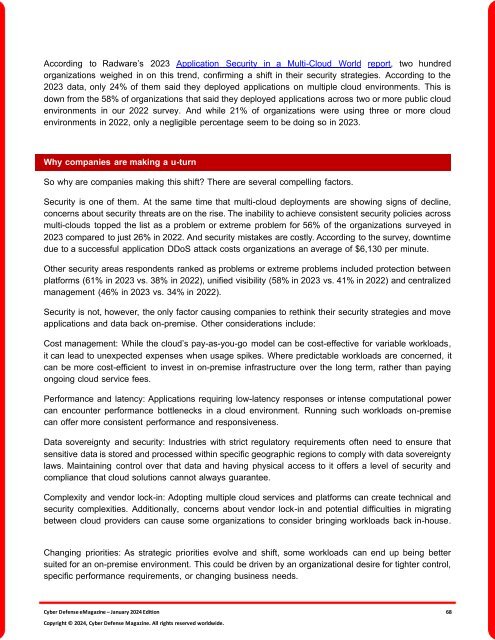The Cyber Defense eMagazine January Edition for 2024
Cyber Defense eMagazine January Edition for 2024 #CDM #CYBERDEFENSEMAG @CyberDefenseMag by @Miliefsky a world-renowned cyber security expert and the Publisher of Cyber Defense Magazine as part of the Cyber Defense Media Group as well as Yan Ross, Editor-in-Chief and many more writers, partners and supporters who make this an awesome publication! 201 page January Edition fully packed with some of our best content. Thank you all and to our readers! OSINT ROCKS! #CDM #CDMG #OSINT #CYBERSECURITY #INFOSEC #BEST #PRACTICES #TIPS #TECHNIQUES
Cyber Defense eMagazine January Edition for 2024 #CDM #CYBERDEFENSEMAG @CyberDefenseMag by @Miliefsky a world-renowned cyber security expert and the Publisher of Cyber Defense Magazine as part of the Cyber Defense Media Group as well as Yan Ross, Editor-in-Chief and many more writers, partners and supporters who make this an awesome publication! 201 page January Edition fully packed with some of our best content. Thank you all and to our readers! OSINT ROCKS! #CDM #CDMG #OSINT #CYBERSECURITY #INFOSEC #BEST #PRACTICES #TIPS #TECHNIQUES
You also want an ePaper? Increase the reach of your titles
YUMPU automatically turns print PDFs into web optimized ePapers that Google loves.
According to Radware’s 2023 Application Security in a Multi-Cloud World report, two hundred<br />
organizations weighed in on this trend, confirming a shift in their security strategies. According to the<br />
2023 data, only 24% of them said they deployed applications on multiple cloud environments. This is<br />
down from the 58% of organizations that said they deployed applications across two or more public cloud<br />
environments in our 2022 survey. And while 21% of organizations were using three or more cloud<br />
environments in 2022, only a negligible percentage seem to be doing so in 2023.<br />
Why companies are making a u-turn<br />
So why are companies making this shift? <strong>The</strong>re are several compelling factors.<br />
Security is one of them. At the same time that multi-cloud deployments are showing signs of decline,<br />
concerns about security threats are on the rise. <strong>The</strong> inability to achieve consistent security policies across<br />
multi-clouds topped the list as a problem or extreme problem <strong>for</strong> 56% of the organizations surveyed in<br />
2023 compared to just 26% in 2022. And security mistakes are costly. According to the survey, downtime<br />
due to a successful application DDoS attack costs organizations an average of $6,130 per minute.<br />
Other security areas respondents ranked as problems or extreme problems included protection between<br />
plat<strong>for</strong>ms (61% in 2023 vs. 38% in 2022), unified visibility (58% in 2023 vs. 41% in 2022) and centralized<br />
management (46% in 2023 vs. 34% in 2022).<br />
Security is not, however, the only factor causing companies to rethink their security strategies and move<br />
applications and data back on-premise. Other considerations include:<br />
Cost management: While the cloud’s pay-as-you-go model can be cost-effective <strong>for</strong> variable workloads,<br />
it can lead to unexpected expenses when usage spikes. Where predictable workloads are concerned, it<br />
can be more cost-efficient to invest in on-premise infrastructure over the long term, rather than paying<br />
ongoing cloud service fees.<br />
Per<strong>for</strong>mance and latency: Applications requiring low-latency responses or intense computational power<br />
can encounter per<strong>for</strong>mance bottlenecks in a cloud environment. Running such workloads on-premise<br />
can offer more consistent per<strong>for</strong>mance and responsiveness.<br />
Data sovereignty and security: Industries with strict regulatory requirements often need to ensure that<br />
sensitive data is stored and processed within specific geographic regions to comply with data sovereignty<br />
laws. Maintaining control over that data and having physical access to it offers a level of security and<br />
compliance that cloud solutions cannot always guarantee.<br />
Complexity and vendor lock-in: Adopting multiple cloud services and plat<strong>for</strong>ms can create technical and<br />
security complexities. Additionally, concerns about vendor lock-in and potential difficulties in migrating<br />
between cloud providers can cause some organizations to consider bringing workloads back in-house.<br />
Changing priorities: As strategic priorities evolve and shift, some workloads can end up being better<br />
suited <strong>for</strong> an on-premise environment. This could be driven by an organizational desire <strong>for</strong> tighter control,<br />
specific per<strong>for</strong>mance requirements, or changing business needs.<br />
<strong>Cyber</strong> <strong>Defense</strong> <strong>eMagazine</strong> – <strong>January</strong> <strong>2024</strong> <strong>Edition</strong> 68<br />
Copyright © <strong>2024</strong>, <strong>Cyber</strong> <strong>Defense</strong> Magazine. All rights reserved worldwide.

















